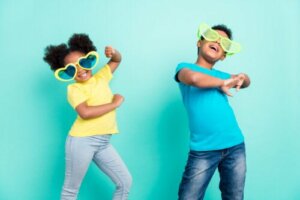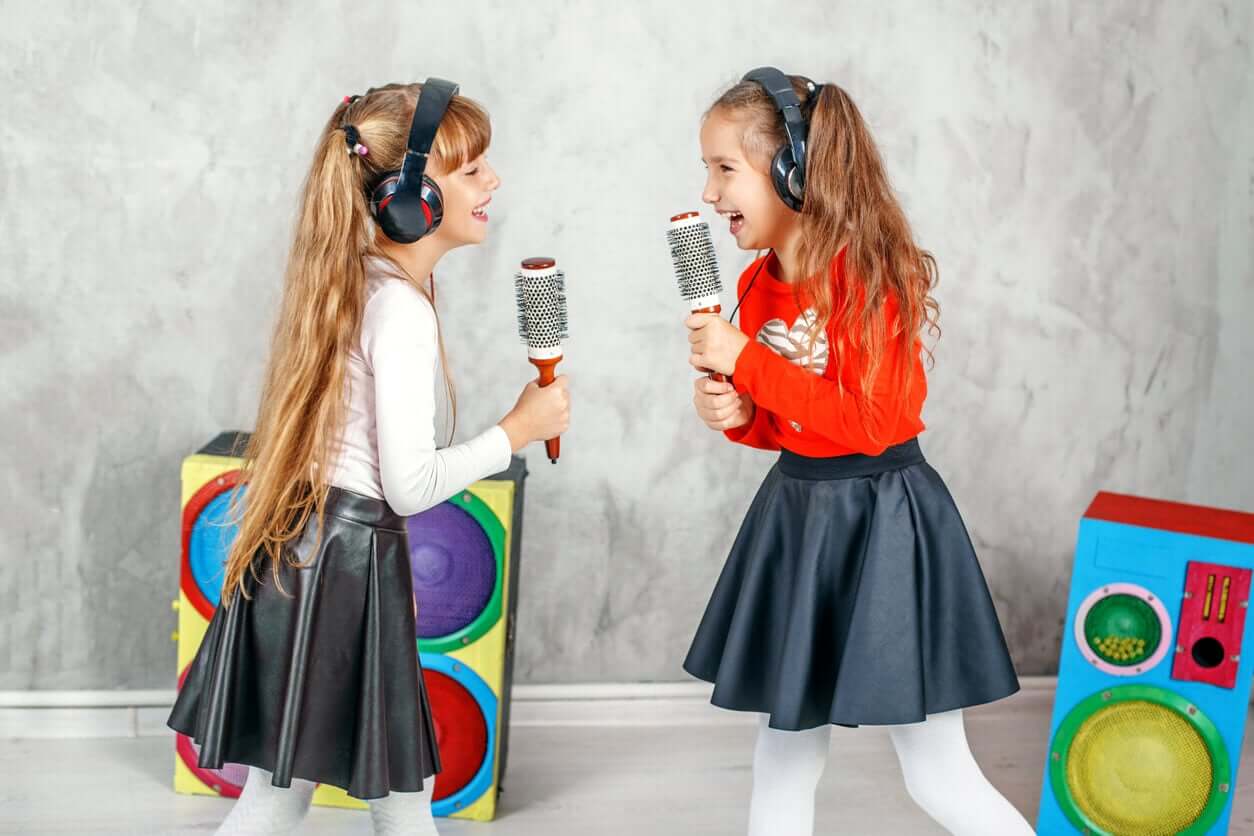12 Activities with Music and Rhythm to Stimulate Creativity in Children


Written and verified by the psychologist Mara Amor López
We all know that music is an excellent educational resource, but did you know that certain musical activities stimulate creativity in children?
From the time babies are in their mother’s belly, experts recommend allowing them to listen to some melodies to help them develop their cognition. In fact, it’s been proven that music offers many benefits for the human brain: It stimulates intelligence, helps overcome certain learning problems, works as a therapeutic strategy for some disorders and deficiencies in children, and increases self-esteem, among others.
As you can see, the advantages of this art are countless and that’s why today, we’re going to suggest some activities with music to stimulate the development and creativity of the little ones in your house. And best of all, you’ll hardly need any preparation or materials. Keep reading!
Activities with music to stimulate creativity in children
Music education has been shown to play an important role in children’s development, so why not take advantage of it at home, too? The activities with music and rhythm that we’re going to teach you below, in addition to stimulating children’s creativity, are a form of entertainment for young and old. Take note!
1. Play different musical instruments
This idea is as simple as giving the children different musical instruments to play: Maracas, flutes, drums, tambourines, bells, a children’s guitar, etc.
In addition to letting them express themselves spontaneously, we can help them discover different rhythms. This way, the activity’s more fun and creative.
2. Use the body to make music
This type of activity is also known as body percussion, as it involves making music with the different parts of our body: Clapping, patting the belly, tapping our feet against the ground, and much more.
3. Make sounds with your mouth
Similar to the above suggestion, we can invite our little ones to experiment with the sounds that are obtained from the different positions of the mouth. For example, saying a long “a” is not the same as a short one, nor does the “o” sound the same when you close your mouth more.
Also, we can plug our noses or whistle, and with these different sounds, invent a melody. It’s sure to sound great!
4. Repeat sounds
If we combine the two previous activities, we can play “Simon Says”. Parents can make different sounds with their bodies and mouths and children have to repeat those rhythms.
In addition to stimulating creativity with this game, you’ll also make them exercise their memory.

5. Imitate sounds
Using the sounds of the environment for children to imitate is very educational and didactic. Try the sound of an animal, the noise of a household appliance, that of a car, or whatever else occurs to you. And best of all, we can do it anywhere, be it a park, the house, or while we go hiking.
6. Listen and describe the sounds of the environment
Sounds in your surroundings can also be used to expand children’s language skills. All you need to do is pay attention to all the sounds around you, be more aware of them, and try to describe them in your own words. You can do it in turns–first the children and then the adults.
In addition to being educational, this activity also allows you to connect with the world around you and stop for a moment to feel and listen.
7. Imagine and invent stories from music or sounds
You can put on a song and ask the children to write a story or a tale based on what the song suggests to them. Of course, you must help them.
More activities with music
8. Dancing
Another great activity to do with music is dancing. You can put on different songs and dance until your feet hurt.
This, in addition to being a lot of fun, helps us relax and feel less inhibited. Also, body movement is the perfect excuse to release that intense energy that all children have and to exercise.
9. Build instruments
In addition to using traditional instruments, you can also make your own instruments with the materials that you have at home. For example, some maracas with some empty bottles and some rice or a guitar with a piece of cardboard and some string or rubber bands.
10. Paint to music
With this activity, you combine two different art forms: Music and graphic art.
To carry it out, you must choose two songs with different rhythms, styles, speeds, and intensities and, once you have them, you’ll do the following:
- Cover the child’s eyes so that they hear the music without looking at anything.
- Ask them to try to draw whatever sensations that song sparked in them.
- Do the same with the second song, and when you have the pictures of both, you’ll discuss with them what their paintings mean.
11. Find a song to explain your emotional state
You can play a game that involves putting on a song that represents your emotional state. You must ask your little one how they feel and what song represents the way they’re feeling. Also, you can ask them what music comes to mind when they’re angry, sad, or happy.
12. Karaoke at home
You can put on a song from YouTube that you like and that all members of the family know. You must opt for its karaoke version and then opt for some of the following activities:
- Play rock band: Imagine you’re a popular music group and sing the songs that inspire you the most in pairs, quartets, or individually. The important thing is to have fun and laugh out loud.
- Have a talent show: If there are many of you, you can make teams and have a competition. A member of the group must serve on the jury and award points for each performance. In the end, the team with the highest score will win the prize.

Conclusion regarding activities with music to stimulate creativity in children…
These activities with music, in addition to stimulating children’s creativity, also offer multiple benefits: They favor the development of intelligence, improve self-esteem, optimize concentration, and allow us to spend very fun times with family.
Don’t hesitate to put these activities into practice with your children, as you’ll help them develop their creativity and have fun with you. Are you ready to get started?
We all know that music is an excellent educational resource, but did you know that certain musical activities stimulate creativity in children?
From the time babies are in their mother’s belly, experts recommend allowing them to listen to some melodies to help them develop their cognition. In fact, it’s been proven that music offers many benefits for the human brain: It stimulates intelligence, helps overcome certain learning problems, works as a therapeutic strategy for some disorders and deficiencies in children, and increases self-esteem, among others.
As you can see, the advantages of this art are countless and that’s why today, we’re going to suggest some activities with music to stimulate the development and creativity of the little ones in your house. And best of all, you’ll hardly need any preparation or materials. Keep reading!
Activities with music to stimulate creativity in children
Music education has been shown to play an important role in children’s development, so why not take advantage of it at home, too? The activities with music and rhythm that we’re going to teach you below, in addition to stimulating children’s creativity, are a form of entertainment for young and old. Take note!
1. Play different musical instruments
This idea is as simple as giving the children different musical instruments to play: Maracas, flutes, drums, tambourines, bells, a children’s guitar, etc.
In addition to letting them express themselves spontaneously, we can help them discover different rhythms. This way, the activity’s more fun and creative.
2. Use the body to make music
This type of activity is also known as body percussion, as it involves making music with the different parts of our body: Clapping, patting the belly, tapping our feet against the ground, and much more.
3. Make sounds with your mouth
Similar to the above suggestion, we can invite our little ones to experiment with the sounds that are obtained from the different positions of the mouth. For example, saying a long “a” is not the same as a short one, nor does the “o” sound the same when you close your mouth more.
Also, we can plug our noses or whistle, and with these different sounds, invent a melody. It’s sure to sound great!
4. Repeat sounds
If we combine the two previous activities, we can play “Simon Says”. Parents can make different sounds with their bodies and mouths and children have to repeat those rhythms.
In addition to stimulating creativity with this game, you’ll also make them exercise their memory.

5. Imitate sounds
Using the sounds of the environment for children to imitate is very educational and didactic. Try the sound of an animal, the noise of a household appliance, that of a car, or whatever else occurs to you. And best of all, we can do it anywhere, be it a park, the house, or while we go hiking.
6. Listen and describe the sounds of the environment
Sounds in your surroundings can also be used to expand children’s language skills. All you need to do is pay attention to all the sounds around you, be more aware of them, and try to describe them in your own words. You can do it in turns–first the children and then the adults.
In addition to being educational, this activity also allows you to connect with the world around you and stop for a moment to feel and listen.
7. Imagine and invent stories from music or sounds
You can put on a song and ask the children to write a story or a tale based on what the song suggests to them. Of course, you must help them.
More activities with music
8. Dancing
Another great activity to do with music is dancing. You can put on different songs and dance until your feet hurt.
This, in addition to being a lot of fun, helps us relax and feel less inhibited. Also, body movement is the perfect excuse to release that intense energy that all children have and to exercise.
9. Build instruments
In addition to using traditional instruments, you can also make your own instruments with the materials that you have at home. For example, some maracas with some empty bottles and some rice or a guitar with a piece of cardboard and some string or rubber bands.
10. Paint to music
With this activity, you combine two different art forms: Music and graphic art.
To carry it out, you must choose two songs with different rhythms, styles, speeds, and intensities and, once you have them, you’ll do the following:
- Cover the child’s eyes so that they hear the music without looking at anything.
- Ask them to try to draw whatever sensations that song sparked in them.
- Do the same with the second song, and when you have the pictures of both, you’ll discuss with them what their paintings mean.
11. Find a song to explain your emotional state
You can play a game that involves putting on a song that represents your emotional state. You must ask your little one how they feel and what song represents the way they’re feeling. Also, you can ask them what music comes to mind when they’re angry, sad, or happy.
12. Karaoke at home
You can put on a song from YouTube that you like and that all members of the family know. You must opt for its karaoke version and then opt for some of the following activities:
- Play rock band: Imagine you’re a popular music group and sing the songs that inspire you the most in pairs, quartets, or individually. The important thing is to have fun and laugh out loud.
- Have a talent show: If there are many of you, you can make teams and have a competition. A member of the group must serve on the jury and award points for each performance. In the end, the team with the highest score will win the prize.

Conclusion regarding activities with music to stimulate creativity in children…
These activities with music, in addition to stimulating children’s creativity, also offer multiple benefits: They favor the development of intelligence, improve self-esteem, optimize concentration, and allow us to spend very fun times with family.
Don’t hesitate to put these activities into practice with your children, as you’ll help them develop their creativity and have fun with you. Are you ready to get started?
All cited sources were thoroughly reviewed by our team to ensure their quality, reliability, currency, and validity. The bibliography of this article was considered reliable and of academic or scientific accuracy.
- Aranda Benito, M. (2021). Desarrollo de la expresión corporal a través de juegos musicales. [Tesis de grado, Universidad de Valladolid]. https://uvadoc.uva.es/handle/10324/49094
- Bravo, J. R. H., Bravo, J. A. H., & Arellano, M. Á. M. (2010). Actividades creativas en educación musical: la composición musical grupal. Ensayos: Revista de la Facultad de Educación de Albacete, (25), 11-23. https://dialnet.unirioja.es/servlet/articulo?codigo=3736481
- Borislavovna Borislova, N. (2017). Desarrollo de la creatividad en la primaria a partir del cuento musical. RIDE. Revista Iberoamericana para la Investigación y el Desarrollo Educativo, 7(14), 265-298. http://www.ride.org.mx/index.php/RIDE/article/view/284
- Gamarra, P. C. M., & López, I. C. (2019). Re-creando: propuesta de estrategias lúdico musicales para promover aprendizajes creativos y significativos en la escuela. En Memorias del quinto Congreso Internacional de Ciencias Pedagógicas de Ecuador: Aprendizaje en la sociedad del conocimiento: modelos, experiencias y propuestos (pp. 1005-1014). Instituto Superior Tecnológico Bolivariano. https://dialnet.unirioja.es/servlet/articulo?codigo=7239555
- Magraner, J. S. B., & Valero, G. B. (2018). La educación musical como potenciadora de la creatividad. Quaderns digitals: Revista de Nuevas Tecnologías y Sociedad, (87), 5. https://dialnet.unirioja.es/servlet/articulo?codigo=6726389
- Martínez Sepúlveda, M. X., & Salcedo Ospina, S. R. (2015). La música, campo artístico para la imaginación y la creatividad en la primera infancia. Boletín de Psicología, No. 93, Julio 2008, 79-97. https://dialnet.unirioja.es/servlet/articulo?codigo=2749038
- Martos Guatusmal , O. F. (2019). Efectos de la música en el cerebro en la etapa infantil: revisión desde las neurociencias. Revista Investigium IRE Ciencias Sociales Y Humanas, 10(2), 65-77. https://doi.org/10.15658/INVESTIGIUMIRE.191002.05
- Rodríguez Soles, E. G., Mamani Porto, M. D., & Paco Incalla, D. (2022). La música: su importancia “inadvertida” para el desarrollo del niño. Paidagogo, 4(1), 62–73. https://doi.org/10.52936/p.v4i1.102
- Rosas, R. E., & Sánchez, O. L. (Eds.). (2019). Las emociones en los procesos pedagógicos y artísticos. ITESO, Universidad Jesuita de Guadalajara. https://rei.iteso.mx/handle/11117/7861
- Tangarife, S. B. (2017). Simón dice Arduino. Ingenio, 8(1), 39-41. https://revistas.upb.edu.co/index.php/ingenio/article/view/1156
This text is provided for informational purposes only and does not replace consultation with a professional. If in doubt, consult your specialist.








